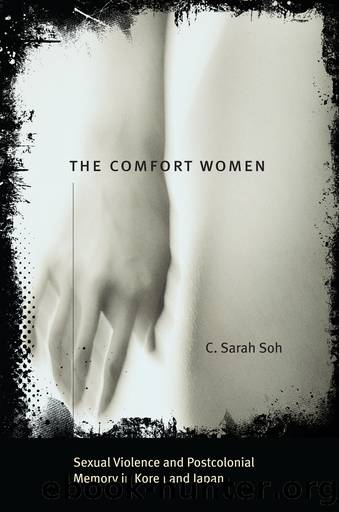The Comfort Women by C. Sarah Soh

Author:C. Sarah Soh
Language: eng
Format: epub
Publisher: University of Chicago Press
Published: 2020-01-15T00:00:00+00:00
Chapter 5
Private Memories of Public Sex
Even now, if there were two men proposing, one Korean and the other Japanese, I would rather marry the Japanese.
âPae Chok-kan, a Korean comfort woman survivor, in Dai Sil Kim-Gibson, Silence Broken, 1999a
Japanese soldiers enjoyed my singing. On my part, I was pleased to see the soldiers having a good time. Not just my sweetheart Yamada IchirÅ but other soldiers as well comforted me; they would say: âI know itâs a hard life here, but I hope you will survive it and return home safely and be a loving child to your parent.â There were many good ones among the Japanese soldiers, and they all had a hard time, and I felt sorry for them.
âMun Ok-chu, a Korean comfort woman survivor, in Mun Ok-chu, Mun Oku-chu: Biruma Sensen Tateshidan no âIanfuâ Datta Watashi, 1996
Donât you know they say there is no national border in love?
âYamada IchirÅ, a Japanese soldier, speaking to Mun Ok-chu, in Mun Ok-chu, Mun Oku-chu: Biruma Sensen Tateshidan no âIanfuâ Datta Watashi, 1996
She became my first love.
âMotoyama, a Japanese soldier speaking of his encounter with a Korean ianfu, in Nishino Rumiko, JÅ«gun Ianfu, 1992
THANKS TO THE KOREAN comfort women movement, the 1990s saw an increase in the production of documentaries and an avalanche of publications on the subject in Japanese, including scholarly works, whichâwith such rare exceptions as those of Suzuki YÅ«ko and Takasaki SÅjiâhad been conspicuously absent. In March 2000 the online database of the Japanese governmentâsupported nonprofit organization Asian Womenâs Fund listed 2,708 Japanese publications, including 1,622 books on the comfort women. Some of these publications were written by people who view the transnational redress movement as ahistorical and an unfair imposition of a postâcold war human rights sensibility on customary sexual behaviors among men in patriarchal societies and among soldiers in war. Individual Japanese veterans have also recounted a variety of personal memories of their experiences of public sex at the comfort facilities as militarized masculine sexual subjects.
Human rights activists and supporters of the comfort women movement in the international community may regard the story of âMadam Xâ as a representative instance of horrific sexual violence committed by Japanese troops. She was a fifteen-year-old Chinese living in British Malaya in 1942 when three solders raped her in full view of her parents and brother. She was then taken by force and made a âcomfort girlâ at the ianjo, which was set up at the Tai Sun Hotel.1 She stated that sex at the ianjo was âexcruciatingâ and that she was paid half of the fee; the âmama-sanâ took the rest, as she did with all the comfort women.2
By contrast, as this chapter demonstrates, the private memories of a number of survivors of their lives at ianjo significantly complicate the categorical images, drawn by the lawyers for the 1994 International Commission of Jurists mission report, of a living hell. Although the vast majority of the countless wartime comfort women, who came from various ethnic and national backgrounds and social circumstances,
Download
This site does not store any files on its server. We only index and link to content provided by other sites. Please contact the content providers to delete copyright contents if any and email us, we'll remove relevant links or contents immediately.
The Rape of Nanking by Iris Chang(3518)
The Sympathizer by Viet Thanh Nguyen(3485)
World without end by Ken Follett(3008)
Ants Among Elephants by Sujatha Gidla(2925)
Blood and Sand by Alex Von Tunzelmann(2610)
Japanese Design by Patricia J. Graham(2556)
City of Djinns: a year in Delhi by William Dalrymple(2136)
Inglorious Empire by Shashi Tharoor(2102)
Foreign Devils on the Silk Road: The Search for the Lost Treasures of Central Asia by Peter Hopkirk(2056)
In Order to Live: A North Korean Girl's Journey to Freedom by Yeonmi Park(2054)
Tokyo by Rob Goss(2018)
India's Ancient Past by R.S. Sharma(1988)
India's biggest cover-up by Dhar Anuj(1984)
The Great Game: On Secret Service in High Asia by Peter Hopkirk(1961)
Tokyo Geek's Guide: Manga, Anime, Gaming, Cosplay, Toys, Idols & More - The Ultimate Guide to Japan's Otaku Culture by Simone Gianni(1947)
Goodbye Madame Butterfly(1936)
The Queen of Nothing by Holly Black(1756)
Living Silence in Burma by Christina Fink(1731)
Batik by Rudolf Smend(1721)
